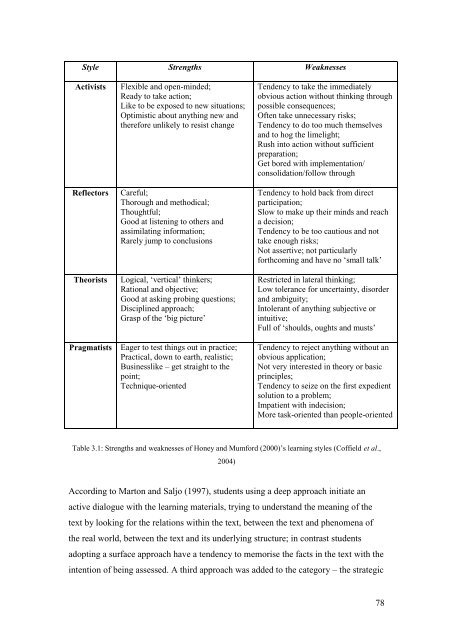The challenge of academic writing for Chinese students within ...
The challenge of academic writing for Chinese students within ...
The challenge of academic writing for Chinese students within ...
You also want an ePaper? Increase the reach of your titles
YUMPU automatically turns print PDFs into web optimized ePapers that Google loves.
Style Strengths Weaknesses<br />
Activists<br />
Reflectors<br />
<strong>The</strong>orists<br />
Pragmatists<br />
Flexible and open-minded;<br />
Ready to take action;<br />
Like to be exposed to new situations;<br />
Optimistic about anything new and<br />
there<strong>for</strong>e unlikely to resist change<br />
Careful;<br />
Thorough and methodical;<br />
Thoughtful;<br />
Good at listening to others and<br />
assimilating in<strong>for</strong>mation;<br />
Rarely jump to conclusions<br />
Logical, ‗vertical‘ thinkers;<br />
Rational and objective;<br />
Good at asking probing questions;<br />
Disciplined approach;<br />
Grasp <strong>of</strong> the ‗big picture‘<br />
Eager to test things out in practice;<br />
Practical, down to earth, realistic;<br />
Businesslike – get straight to the<br />
point;<br />
Technique-oriented<br />
Tendency to take the immediately<br />
obvious action without thinking through<br />
possible consequences;<br />
Often take unnecessary risks;<br />
Tendency to do too much themselves<br />
and to hog the limelight;<br />
Rush into action without sufficient<br />
preparation;<br />
Get bored with implementation/<br />
consolidation/follow through<br />
Tendency to hold back from direct<br />
participation;<br />
Slow to make up their minds and reach<br />
a decision;<br />
Tendency to be too cautious and not<br />
take enough risks;<br />
Not assertive; not particularly<br />
<strong>for</strong>thcoming and have no ‗small talk‘<br />
Restricted in lateral thinking;<br />
Low tolerance <strong>for</strong> uncertainty, disorder<br />
and ambiguity;<br />
Intolerant <strong>of</strong> anything subjective or<br />
intuitive;<br />
Full <strong>of</strong> ‗shoulds, oughts and musts‘<br />
Tendency to reject anything without an<br />
obvious application;<br />
Not very interested in theory or basic<br />
principles;<br />
Tendency to seize on the first expedient<br />
solution to a problem;<br />
Impatient with indecision;<br />
More task-oriented than people-oriented<br />
Table 3.1: Strengths and weaknesses <strong>of</strong> Honey and Mum<strong>for</strong>d (2000)‘s learning styles (C<strong>of</strong>field et al.,<br />
2004)<br />
According to Marton and Saljo (1997), <strong>students</strong> using a deep approach initiate an<br />
active dialogue with the learning materials, trying to understand the meaning <strong>of</strong> the<br />
text by looking <strong>for</strong> the relations <strong>within</strong> the text, between the text and phenomena <strong>of</strong><br />
the real world, between the text and its underlying structure; in contrast <strong>students</strong><br />
adopting a surface approach have a tendency to memorise the facts in the text with the<br />
intention <strong>of</strong> being assessed. A third approach was added to the category – the strategic<br />
78


